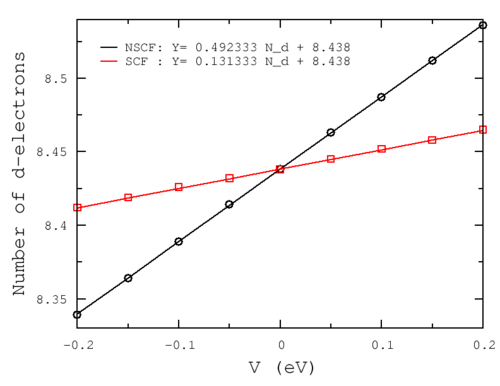Calculate U for LSDA+U
Task
In this exercise you will calculate the U parameter for the LSDA+U treatment of Ni d-electrons in NiO using the linear response ansatz of Cococcioni et al..[1]
POSCAR
For this calculation we will use a 2×2×2 supercell of AFM-II NiO:
AFM NiO 4.03500000 2.0000000000 1.0000000000 1.0000000000 1.0000000000 2.0000000000 1.0000000000 1.0000000000 1.0000000000 2.0000000000 1 15 16 Direct 0.0000000000 0.0000000000 0.0000000000 0.2500000000 0.2500000000 0.2500000000 0.0000000000 0.0000000000 0.5000000000 0.2500000000 0.2500000000 0.7500000000 0.0000000000 0.5000000000 0.0000000000 0.2500000000 0.7500000000 0.2500000000 0.0000000000 0.5000000000 0.5000000000 0.2500000000 0.7500000000 0.7500000000 0.5000000000 0.0000000000 0.0000000000 0.7500000000 0.2500000000 0.2500000000 0.5000000000 0.0000000000 0.5000000000 0.7500000000 0.2500000000 0.7500000000 0.5000000000 0.5000000000 0.0000000000 0.7500000000 0.7500000000 0.2500000000 0.5000000000 0.5000000000 0.5000000000 0.7500000000 0.7500000000 0.7500000000 0.1250000000 0.1250000000 0.1250000000 0.3750000000 0.3750000000 0.3750000000 0.1250000000 0.1250000000 0.6250000000 0.3750000000 0.3750000000 0.8750000000 0.1250000000 0.6250000000 0.1250000000 0.3750000000 0.8750000000 0.3750000000 0.1250000000 0.6250000000 0.6250000000 0.3750000000 0.8750000000 0.8750000000 0.6250000000 0.1250000000 0.1250000000 0.8750000000 0.3750000000 0.3750000000 0.6250000000 0.1250000000 0.6250000000 0.8750000000 0.3750000000 0.8750000000 0.6250000000 0.6250000000 0.1250000000 0.8750000000 0.8750000000 0.3750000000 0.6250000000 0.6250000000 0.6250000000 0.8750000000 0.8750000000 0.8750000000
Atoms 1-16 are Ni and atoms 17-32 are O.
Note that the Ni atoms are split into two groups: atom 1, and atom 2-15. This trick breaks the symmetry of the Ni sub-lattice and allows us to treat atom 1 differently from atom 2-15. Our POTCAR file has to reflect the fact that we now formally have 3 "species" (2 ×Ni + 1×O), i.e., we concatenate two Ni POTCAR files and one O POTCAR file:
cat Ni/POTCAR Ni/POTCAR O/POTCAR > POTCAR
KPOINTS
Gamma only 0 Monkhorst 1 1 1 0 0 0
References
Back to the main page.

